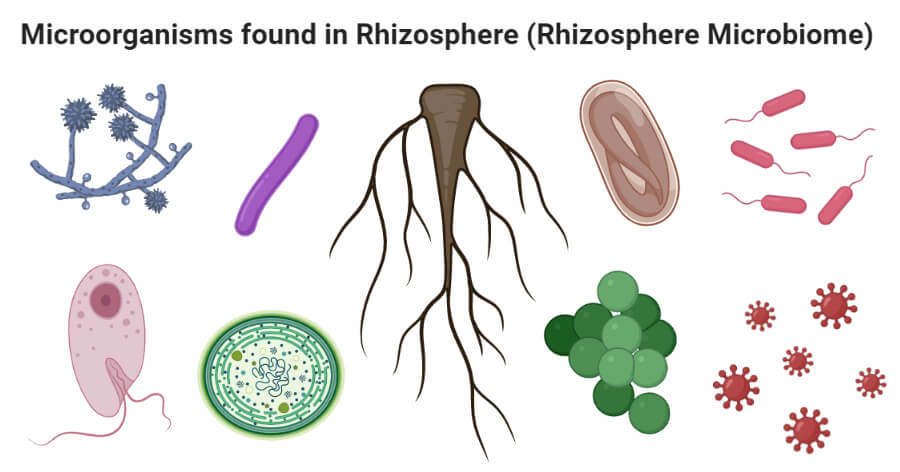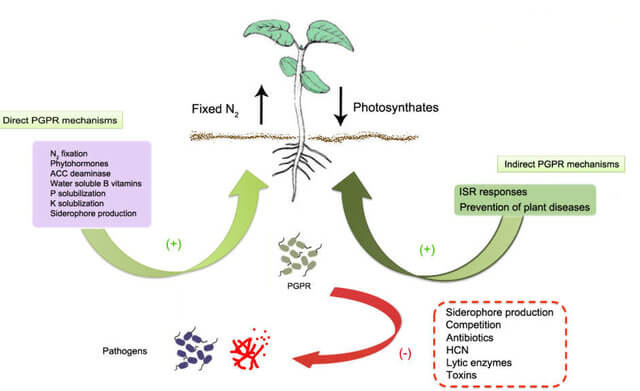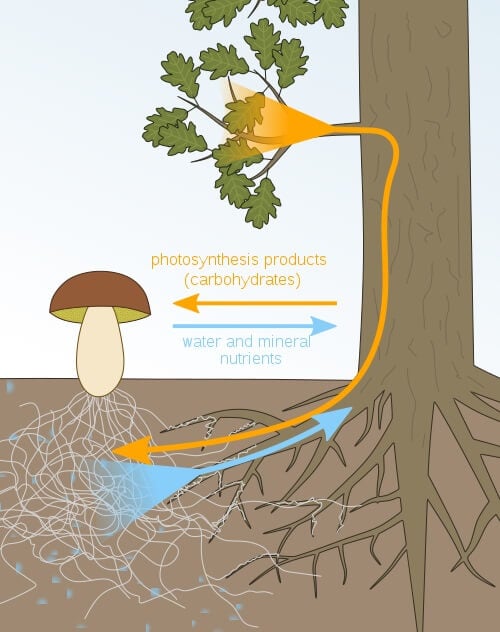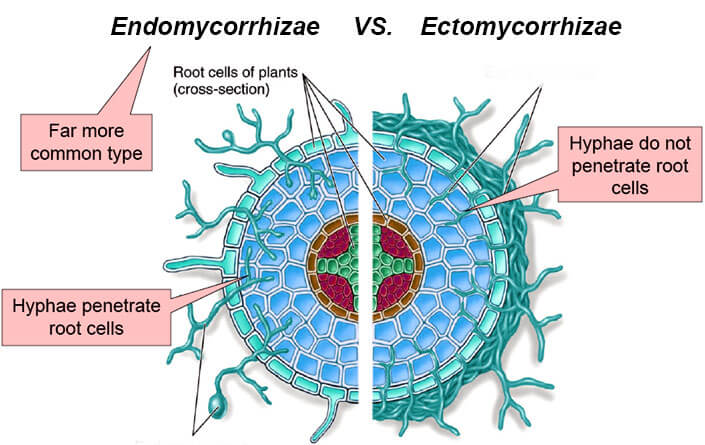Interesting Science Videos
What is Rhizosphere?
- The rhizosphere is the narrow region of soil around the plant root that is influenced by several factors like the root exudates and the associated soil microorganisms.
- The rhizosphere is considered the most active region of soil as it receives the nutrients from the nutrients, in addition to the microorganisms that are present around the root.
- It is a dynamic environment fluctuating with the stages of root growth and senescence.
- Rhizosphere as a region was defined more than a century ago by Lorenz Hiltner as a soil compartment influenced by plant roots.
- The rhizosphere is an important part of soil microbiology which is responsible for various metabolic processes occurring in the soil like cycling of nutrients and uptake of carbon.
- The roots of crop plants create an interface between the plant and the soil environment, thus establishing an enormous reservoir of the microbial community.
- The area of rhizosphere usually extends a few millimeters from the root surface where the roots release various compounds like root exudates, mucilage, and sloughed-off root cells that support higher microbial populations and activities than in bulk soil.

What is the Rhizosphere effect?
- The rhizosphere effect is the influence of plant roots on the development of soil microorganisms as a result of the physical and chemical alteration of soil and the release of root secretions and exudates within the rhizosphere.
- The rhizospheric effect is observed on the basis of the microbial biomass of the rhizosphere when compared to the biomass of the bulk soil.
- The rhizosphere effect on soil microbial population can be measured by comparing the population density [colonies forming units (CFU)] between the rhizosphere soil (R) and the bulk soil (S), for which the “R/ S ratio” is employed.
- The rhizosphere effect is higher for bacteria > fungi > actinomycetes > protozoa.
- The microorganism diversity is higher near to the rhizoplane, which then decreases with an increase in distance from the rhizoplane.
- The interaction between plant nutrients in soil and plant exudates modifies the microclimate of the rhizosphere.
- The rhizosphere effect is a result of the interaction between the plant root and the microbial community of the region, where both factors influence each other.
- In the rhizosphere, microbial activity influences the plant root, and the plant root secretions influence the microbial biomass.
Microorganisms found in Rhizosphere (Rhizosphere microbiome)
- The microbial population in the rhizosphere consists of different groups of microorganisms like bacteria, fungi, parasites, viruses, and algae.
- The microbial population in the rhizosphere is known as the rhizosphere microbiome and the microbial population in such an area much higher than the bulk soil.
- In the rhizosphere, there is a microbial population distinct from the rest of the soil.
- Bacteria in the rhizosphere are larger and have higher proportions of Gram-negative and denitrifying bacteria than those in the bulk soil.
- Rhizosphere fungal populations, abundant in both pathogenic and mycorrhizal species, can be 10 to 20 times higher than those in the non-rhizosphere.
- Protozoa and other microfauna also thrive in the rhizosphere because that is where food is most plentiful.
- The type and population of microorganisms in the rhizosphere are highly influenced by the type of plant grown on the soil.
- Microbes in the bulk soil often experience long periods of nutrient deprivation; they have different survival strategies in dealing with starvation and stress.
- The rhizosphere bacterial community is recruited from the main reservoir of microorganisms present in the soil.
- Next to the recruitment of specific soil microbes into the rhizosphere microbiome, plant roots also influence specific functions of the microbiome.
- Some of the examples of microorganisms found in the rhizosphere region include Bacillus, Arthrobacter, Pseudomonas, Agrobacterium, Alcaligenes, Clostridium, Flavobacterium, Corynebacterium, Micrococcus, Xanthomonas, Amanita, Tricholoma, Torrendia, Descomyces, Thelephora, Verticillium, Phytophthora, Rhizoctonia, Micromonospora, Thermoactinomycetes, Amycolaptosis, Actinomadura, etc.
Plant Growth Promoting Rhizobacteria (PGPR)

Figure: Mechanism of plant growth-promoting rhizobacteria (PGPR). Image Source: Durdana Shah (Researchgate).
- Plant Growth Promoting Rhizobacteria (PGPR) are a group of bacteria that enhances plant growth via various plant growth-promoting substances as well as biofertilizers.
- PGPR act as biofertilizers are efficient soil microbes for sustainable agriculture and hold great promise in the improvement of agriculture yields.
- These bacteria enhance crop growth and can help in the sustainability of the safe environment and crop productivity.
- The rhizospheric soil contains diverse types of PGPR communities, which exhibit beneficial effects on crop productivity.
- Some common examples of PGPR genera exhibiting plant growth-promoting activity are Pseudomonas, Azospirillum, Erwinia, Mycobacterium, Azotobacter, Bacillus, Burkholderia, Enterobacter, Rhizobium, Mesorhizobium, Flavobacterium, etc.
- PGPR have different roles in promoting soil health as well as crop health. These bacteria function as biofertilizers, biocontrol agents, and biological fungicides.
- The function of PGPR as biofertilizers is by virtue of the production of growth-stimulating phytohormones such as indole-3-acetic acid (IAA), gibberellic acid (GA3 ), zeatin, ethylene, and abscisic acid.
- Besides, these bacteria also promote plant nutrition as bacteria like Rhizobium act as phosphate solubilizing bacteria increase the availability of accumulated phosphate, increase the efficiency of biological nitrogen fixation and render availability of iron and zinc through the production of plant growth-promoting substances.
- PGPR also protects plants against pathogens by direct antagonistic interactions between the biocontrol agent and the pathogen, as well as by induction of host resistance.
Factors influencing their growth and activities
Microbial growth and activities in soil depend on resources (carbon and other mineral nutrients) available and the physiochemical conditions of their habitat.
A. Nutrients
- The majorities of soil microorganisms are presumably chemoorganoheterotrophic and use organic compounds as carbon and energy sources.
- The humic fraction of soil organic matter provides the stable microbial nutrient base for microorganisms; however, humic substances have incredibly complex structures and are resistant to decomposition.
- In addition, humus is associated with mineral particles and forms organo-clay complexes. Therefore, humus only serves as a slow-release source of carbon and energy for oligotrophic microorganisms.
- In the rhizospheric area, other forms of nutrients are released by the plant in the form of root secretions and root exudates.
B. Physiochemical factors of soil
- The physical factors of soil like soil moisture, soil atmosphere, and soil temperature also affect the growth and activities of microorganisms in the soil and the rhizosphere region.
- Soil water affects not only the moisture available to organisms, but also the soil aeration status, soil temperature, and a variety of soil chemical reactions.
- Soil temperature affects the rates of physical, chemical, and biological processes in the soil.
- Soil pH influences microorganisms indirectly by changing the chemical forms, solubility, and availability of chemical compounds.
C. Interactions
- Different soil organisms frequently interact with each other; the interactions can be positive, negative, or neutral.
- Positive interactions (commensalism, synergism, and mutualism) enhance the abilities of populations to survive within a particular habitat; negative interactions (competition, amensalism, and predation/ parasitism) limit the population growth.
- Interactions like symbiosis and mycorrhiza favor the growth of organisms and their activities in the soil.
What is Mycorrhiza?

Figure: Within mutualistic mycorrhiza, the plant gives carbohydrates (products of photosynthesis) to the fungus, while the fungus gives the plant water and minerals in exchange. Image Source: Nefronus.
- Mycorrhiza is an association formed between the plant root and a fungal species as a result of non-disease-producing infection.
- The term ‘mycorrhiza’ indicates a symbiotic relationship between the roots of green plants and fungi.
- The mycorrhizal association is considered a mild form of parasitism, more accurately called mutualism, where both the plants and the fungi are benefitted from each other.
- Mycorrhizal fungi are crucial for mineral uptake by plants while fungi also receive nutrients from plants in return.
- About 90% of all land plants depend on mycorrhizal fungal for minerals like phosphorus.
- Mycorrhizal associations are born out of necessity, in the case of plants growing in soil that is deficient in nutrients.
- In some cases, mycorrhiza might even be harmful to the plant species that might range from mild to severe.
- The exchange of nutrients between the plants and the fungi is an essential part of nutrient cycles, ecology, evolution, and the overall physiology of plants.
- The primary function of the fungi in such association is to provide water and nutrients from the soil to the plant while the plants share the nutrients formed via photosynthesis to the plants.
Types (Ectomycorrhiza and Endomycorrhiza)
Mycorrhizal associations are of two types depending on the presence of fungi on the plant body.
A. Ectomycorrhiza
- Ectomycorrhiza is fungi that form an external association with plant roots and do not reach the cells of the root.
- Ectomycorrhiza is formed by various basidio-, asco- and zygomycetes as well as by fungi imperfecti.
- Their morphology, physiological abilities, adaptability, and their benefit to the plants vary.
- The hyphae of the ectomycorrhizal mycobiont penetrate between cells of the cortex of the root to form a branched structure called the “Hartig net”, as well as forming a compact “mantle” (sheath) surrounding the rootlet.
- The extensive mycelium facilitates more efficient growth for the phycobiont due to improved nutrient and water uptake. Furthermore, considerable amounts of nutrient salts can be stored in the fungal mantle.
- Ectomycorrhiza usually forms symbiotic associations with hard woody plants, and it accounts for about 5 to 10% of the mycorrhizal associations formed in terrestrial plants.
- Rootlets of plants colonized by ectomycorrhizal fungi often exhibit more ramification and initiate characteristic, often club-shaped, swollen short roots.
- These morphological changes are caused by auxins and growth regulators synthesized by the mycobionts.
B. Endomycorrhiza
- Endomycorrhiza is fungi that form an association with plant roots by penetrating the cortical cells of the root tissue.
- Endomycorrhiza accounts for about 80% of all the fungal associations with terrestrial plants. It occurs in many plant species ranging from vegetables, flowers, fruits, and trees.
- The hyphae of endomycorrhiza extend out of the root representing a more invasive relationship between the plant root and the fungi.
- Two distinct root structures are seen in the case of endomycorrhiza in the form of vesicles (for storage) and arbuscules (nutrient exchange).
- Endomycorrhiza is further classified as arbuscular, ericoid, or orchid, based on the host plants and structural nature of the symbiosis found in each group.
- Endomycorrhiza, like ectomycorrhiza, is involved in absorbing nutrients (especially phosphorus) from soil to provide them to the plants while receiving nutrients from the plant.
Differences between Ectomycorrhiza and Endomycorrhiza

Image Source: Mold Resistant Strains.
| Basis for Comparison | Ectomycorrhiza | Endomycorrhiza |
| Definition | Ectomycorrhiza is an external association of the fungi with plant root that does not reach the cells of the root.
| Endomycorrhiza is an association of fungi with plant roots by penetrating the cortical cells of the root tissue. |
| Occurrence | Ectomycorrhiza accounts for about 5 to 10% of the mycorrhizal associations formed in terrestrial plants. | Endomycorrhiza accounts for about 80% of all the fungal associations with terrestrial plants. |
| Hartig Net | Ectomycorrhiza form Hartig Net around the root tissue. | No Hartig Net is formed in the case of endomycorrhiza. |
| Vesicles and Arbuscules | No vesicles or arbuscules are formed in ectomycorrhiza. | Endomycorrhiza results in vesicles and arbuscules in the plant root. |
| Hyphae | The fungal hyphae form a mantle over the surface of the root which then grows out into the soil. | The fungal hyphae form a loose network in the soil and an extensive growth over the plant root. |
| Fungi involved | Fungi like Basidiomycota and Ascomycota are involved in ectomycorrhiza. | Fungi of the group Glomeromycota are involved in endomycorrhiza. |
| Penetration | Ectomycorrhiza does not penetrate the cortical cells of the root tissue. | Endomycorrhiza penetrates the cortical cells of the root tissue. |
| Artificial culture | Ectomycorrhiza can be culture on artificial media. | Endomycorrhiza cannot be cultured on artificial media. |
| Morphological changes in the root | Ectomycorrhiza does not result in morphological changes in the plant root. | Endomycorrhiza results in ramification and initiates characteristics, often club-shaped, swollen short roots. |
| Plants | Ectomycorrhiza is commonly associated with temperate forest tree roots. | Endomycorrhiza is commonly associated with agricultural and horticultural plants. |
Functions of Mycorrhiza
- The most important function of mycorrhiza is to exchange nutrients between the surrounding and the host plants.
- Considerable amounts of nutrient salts can be stored in the fungal mycelium which then facilitates rapid activation of metabolism at the beginning of the growing season for plants at suboptimal locations like at high altitude.
- The fungal mycelium can further act as a significant barrier against infections caused by other microorganisms.
- Endomycorrhiza is essential for the formation of lateral roots and the absorption of essential minerals like sulfur and phosphorus.
- Mycorrhiza also alters nitrogen acquisition which improves plant growth.
- Ectomycorrhiza is known to be involved in the decomposition process and the mobilization of nitrogen from organic matter.
- These associations also enhance the tolerance of plants to difficult environmental conditions and salinity.
- Mycorrhizae are involved in phytoremediation processes by decreasing aluminum toxicity, improving plant oxidant systems.
Positive effect of Rhizospheric microorganisms on Plants
- Rhizospheric microorganisms play an important role in the ecological fitness of the plant and the soil.
- Important microbial processes like plant protection, growth promotion, production of antibiotics, geochemical cycling, and plant colonization take place in the rhizosphere.
- Rhizospheric microorganisms increase the supply of mineral nutrients from the soil to the plant.
- Another group of microorganisms in the rhizosphere stimulate plant growth indirectly by preventing the growth or activity of plant pathogens.
- These microorganisms are responsible for direct growth promotion by the production of phytohormones.
- Plant growth-promoting rhizobacteria act as biofertilizers by enhancing phytochrome production, phosphate solubilization, and siderophore production.
- The capacity of rhizospheric organisms to synthesize anti-fungal metabolites such as antibiotics, fungal cell wall-lysing enzymes, or hydrogen cyanide suppresses the growth of fungal pathogens.
Negative effect of Rhizospheric microorganisms on Plants
- One of the most important negative effects of rhizosphere microorganisms is a competition where the microorganisms compete with the plants for water, nutrient, and space.
- Some of the members of the rhizosphere microbiome might act as plant pathogens, resulting in different forms of plant diseases.
- Competition between the microorganisms in the microbial community in the rhizosphere can even result in the loss of beneficial microorganisms.
References
- Gupta R.K. et al. (2008) Soil Microbiology. In: Chesworth W. (eds) Encyclopedia of Soil Science. Encyclopedia of Earth Sciences Series. Springer, Dordrecht. https://doi.org/10.1007/978-1-4020-3995-9_544
- Beneduzi A, Ambrosini A, Passaglia LM. Plant growth-promoting rhizobacteria (PGPR): Their potential as antagonists and biocontrol agents. Genet Mol Biol. 2012;35(4 (suppl)):1044-1051. doi:10.1590/s1415-47572012000600020
- Podile A.R., Kishore G.K. (2007) Plant growth-promoting rhizobacteria. In: Gnanamanickam S.S. (eds) Plant-Associated Bacteria. Springer, Dordrecht. https://doi.org/10.1007/978-1-4020-4538-7_6
- Singh, J.S. Plant Growth Promoting Rhizobacteria. Reson18, 275–281 (2013). https://doi.org/10.1007/s12045-013-0038-y
- Bakker PA, Berendsen RL, Doornbos RF, Wintermans PC, Pieterse CM. The rhizosphere revisited: root microbiomics. Front Plant Sci. 2013;4:165. Published 2013 May 30. doi:10.3389/fpls.2013.00165
- Dotaniya, M. & Meena, Vasudev. (2015). Rhizosphere Effect on Nutrient Availability in Soil and Its Uptake by Plants: A Review. Proceedings of the National Academy of Sciences, India Section B: Biological Sciences. 85. 10.1007/s40011-013-0297-0.
- Nihorimbere, Venant & Ongena, Marc & Smargiassi, Maite & Thonart, Philippe. (2011). Beneficial effect of the rhizosphere microbial community for plant growth and health. Biotechnology, Agronomy, Society and Environment. 15. 327-337.
- Ng, T.B. & Ng, C.C.W.. (2014). Functions of mycorrhizae.
- Alström, S. Factors associated with detrimental effects of rhizobacteria on plant growth. Plant Soil102, 3–9 (1987). https://doi.org/10.1007/BF02370892
- Pöder, R. (1996). Ectomycorrhizae. Methods in Soil Biology, 281–294. doi:10.1007/978-3-642-60966-4_18.
Sources
- 3% – https://www.ias.ac.in/article/fulltext/reso/018/03/0275-0281
- 2% – https://microbenotes.com/microorganisms-in-soil/
- 1% – https://www.slideshare.net/SandeepKumar3250/mycorrhiza-90231144
- 1% – https://www.sciencedirect.com/topics/immunology-and-microbiology/endomycorrhiza
- 1% – https://www.sciencedirect.com/science/article/pii/S0167880911000351
- 1% – https://www.researchgate.net/publication/301103025_Indolic_and_Phenolic_Compounds
- 1% – https://www.researchgate.net/publication/270649856_Rhizosphere_Effect_on_Nutrient_Availability_in_Soil_and_Its_Uptake_by_Plants_A_Review
- 1% – https://www.medicinalplantsarchive.us/ectomycorrhizal-fungi/ii-the-general-features-of-mycorrhizal-symbiosis.html
- 1% – https://www.ias.ac.in/public/Volumes/reso/018/03/0275-0281.pdf
- 1% – http://europepmc.org/articles/PMC3667247
- 1% – http://bsmrau.edu.bd/seminar/wp-content/uploads/sites/318/2018/05/Monjur-Morshed-13-05-3012-1.pdf
- <1% – https://www.thoughtco.com/how-do-species-interact-130924
- <1% – https://www.sciencedirect.com/topics/earth-and-planetary-sciences/soil-temperature
- <1% – https://www.sciencedirect.com/science/article/pii/S1878818118306546
- <1% – https://www.sciencedirect.com/science/article/pii/S1360138512000799
- <1% – https://www.sciencedirect.com/science/article/pii/S0301479718303980
- <1% – https://www.researchgate.net/publication/334507715_rhizosphere_colonization
- <1% – https://www.researchgate.net/publication/322419790_Physical_Chemical_and_Biological_Characteristics_of_Water_e_Content_Module
- <1% – https://www.researchgate.net/publication/297824614_Beneficial_effect_of_the_rhizosphere_microbial_community_for_plant_growth_and_health
- <1% – https://www.researchgate.net/publication/295456703_Effect_of_rhizospheric_micro-organisms_on_growth_and_yield_of_greengram_Phaseolus_radiatus
- <1% – https://www.nature.com/scitable/knowledge/library/the-rhizosphere-roots-soil-and-67500617/
- <1% – https://www.merriam-webster.com/dictionary/rhizosphere%20effect
- <1% – https://www.longdom.org/open-access/plant-growth-promoting-rhizobacteria-mechanism-and-current-prospective-jbfbp-1000155.pdf
- <1% – https://www.intechopen.com/books/plant-ecology-traditional-approaches-to-recent-trends/plant-microbe-ecology-interactions-of-plants-and-symbiotic-microbial-communities
- <1% – https://www.gardenmyths.com/mycorrhizae-fungi-inoculant-products/
- <1% – https://www.differencebetween.com/difference-between-ectomycorrhizae-and-endomycorrhizae/
- <1% – https://soilandhealth.org/wp-content/uploads/Development-and-Activities-of-Roots.pdf
- <1% – https://quizlet.com/56967973/ch-12-flash-cards/
- <1% – https://pediaa.com/what-is-the-difference-between-ectomycorrhizae-and-endomycorrhizae/
- <1% – https://onlinelibrary.wiley.com/doi/pdf/10.1111/1574-6976.12028
- <1% – https://en.wikipedia.org/wiki/Rhizosphere
- <1% – https://en.wikipedia.org/wiki/Humus
- <1% – https://en.wikipedia.org/wiki/Arbuscular_mycorrhiza
- <1% – https://bio.libretexts.org/Bookshelves/Microbiology/Book%3A_Microbiology_(Boundless)/16%3A_Microbial_Ecology/16.2%3A_Soil_and_Plant_Microbiology/16.2C%3A_Mycorrhiza

Very important source of information or knowledge